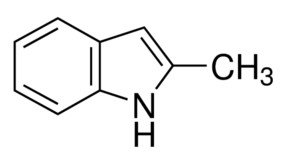2-Methyl-1H-indole CAS#: 95-20-5; ChemWhat Code: 1288969
Identification
| Patent Information | ||
| Patent ID | Title | Publication Date |
| CN113943244 | A sulfur-containing γ, γ-diindolebutamide compound prepared by bifunctional reaction | 2022 |
| EP2698384 | Detection of synthetic cannabinoids | 2014 |
Physical Data
| Appearance | Buff CoYellow to Reddish – Purple or Brown Crystals |
| Solubility | No data available |
| Flash Point | No data available |
| Refractive index | No data available |
| Sensitivity | No data available |
| Melting Point, °C |
| 53 – 55 |
| 56 – 58 |
| 52 |
| 61 |
| Boiling Point, °C | Pressure (Boiling Point), Torr |
| 273 | |
| 274.2 | 760 |
| 114 – 116 | 2 |
| 272 | 750 |
| Refractive Index | Wavelength (Refractive Index), nm | Temperature (Refractive Index), °C |
| 1.58734 | 656.3 | 78.4 |
| 1.59481 | 587.6 | 78.4 |
| 1.61426 | 486.1 | 78.4 |
| Density, g·cm-3 | Reference Temperature, °C | Measurement Temperature, °C |
| 1.0325 | 4 | 78.4 |
| Description (Association (MCS)) | Solvent (Association (MCS)) | Temperature (Association (MCS)), °C | Partner (Association (MCS)) |
| Adsorption | water | 25 | peroxide-modied titania nanosheets |
| Adsorption | water | 25 | titanium(IV) oxide |
| Adsorption isotherm | H2O | CdS | |
| Adsorption | |||
| Enthalpy of adsorption |
Spectra
| Description (NMR Spectroscopy) | Nucleus (NMR Spectroscopy) | Solvents (NMR Spectroscopy) | Frequency (NMR Spectroscopy), MHz |
| Chemical shifts | 1H | chloroform-d1 | 400 |
| Chemical shifts, Spectrum | 1H | chloroform-d1 | 600 |
| Chemical shifts, Spectrum | 13C | chloroform-d1 | 151 |
| Chemical shifts | 13C | chloroform-d1 | 101 |
| Description (IR Spectroscopy) | Solvent (IR Spectroscopy) |
| Bands | potassium bromide |
| ATR (attenuated total reflectance), Bands | neat (no solvent, solid phase) |
| Mid IR (MIR), Bands | potassium bromide |
| Description (Mass Spectrometry) |
| high resolution mass spectrometry (HRMS), time-of-flight mass spectra (TOFMS), electrospray ionisation (ESI), spectrum |
| high resolution mass spectrometry (HRMS), spectrum |
| electron impact (EI), spectrum |
| gas chromatography mass spectrometry (GCMS), spectrum |
| Description (UV/VIS Spectroscopy) | Solvent (UV/VIS Spectroscopy) | Comment (UV/VIS Spectroscopy) | Absorption Maxima (UV/VIS), nm | Ext./Abs. Coefficient, l·mol-1cm-1 |
| Spectrum | acetonitrile | 300 | ||
| Solvatochromism, Spectrum | methylbutane | |||
| acetonitrile | 270, 288, 220 | 6600, 4700, 30300 | ||
| Spectrum | polyethylene | 200 – 350 nm | ||
| Absorption maxima | polyethylene | Ratio of solvents: 66percent | 288, 266, 218 | |
| Absorption maxima | gaseous matrix | Ratio of solvents: 0.1N | 284.33 |
Route of Synthesis (ROS)
| Conditions | Yield |
| With 5% Pd(II)/C(eggshell); hydrogen; trifluoroacetic acid In dichloromethane at 0℃; under 760.051 Torr; reductive Friedel-Crafts alkylation; | 83% |
| With triethylsilane; trifluoroacetic acid In dichloromethane at 0℃; | 58% |
| With triethylsilane; trifluoroacetic acid | |
| Multi-step reaction with 2 steps 1: acetonitrile / 0.5 h / 20 – 25 °C 2: sodium tetrahydroborate / acetonitrile / 0.17 h / 20 – 25 °C | |
| With 5%-palladium/activated carbon; hydrogen; trifluoroacetic acid In dichloromethane at 0℃; under 760.051 Torr; |
Safety and Hazards
| Pictogram(s) |  |
| Signal | Danger |
| GHS Hazard Statements | H318 (92.81%): Causes serious eye damage [Danger Serious eye damage/eye irritation] Information may vary between notifications depending on impurities, additives, and other factors. |
| Precautionary Statement Codes | P280, P305+P351+P338, and P310 (The corresponding statement to each P-code can be found at the GHS Classification page.) |
Other Data
| Transportation | NONH for all modes of transport |
| Under the room temperature and away from light | |
| HS Code | No data available |
| Storage | Under the room temperature and away from light |
| Shelf Life | 2 years |
| Market Price | USD |
| Druglikeness | |
| Lipinski rules component | |
| Molecular Weight | 131.177 |
| logP | 2.411 |
| HBA | 1 |
| HBD | 1 |
| Matching Lipinski Rules | 4 |
| Veber rules component | |
| Polar Surface Area (PSA) | 15.79 |
| Rotatable Bond (RotB) | 0 |
| Matching Veber Rules | 2 |
| Use Pattern |
| 2-Methyl-1H-indole CAS#: 95-20-5 is useds as the intermediates of Basic Orange 21 and 2 Methyl Indoline. |
| 2-Methyl-1H-indole CAS#: 95-20-5 eye irritations, headaches, rashes, and sneezing |
Buy Reagent | |
| No reagent supplier? | Send quick inquiry to ChemWhat |
| Want to be listed here as a reagent supplier? (Paid service) | Click here to contact ChemWhat |
Approved Manufacturers | |
| Warshel Chemical Ltd | http://www.warshel.com/ |
| Want to be listed as an approved manufacturer (Requires approvement)? | Please download and fill out this form and send back to approved-manufacturers@chemwhat.com |
Other Suppliers | |
| Watson International Limited | Visit Watson Official Website |
Contact Us for Other Help | |
| Contact us for other information or services | Click here to contact ChemWhat |



